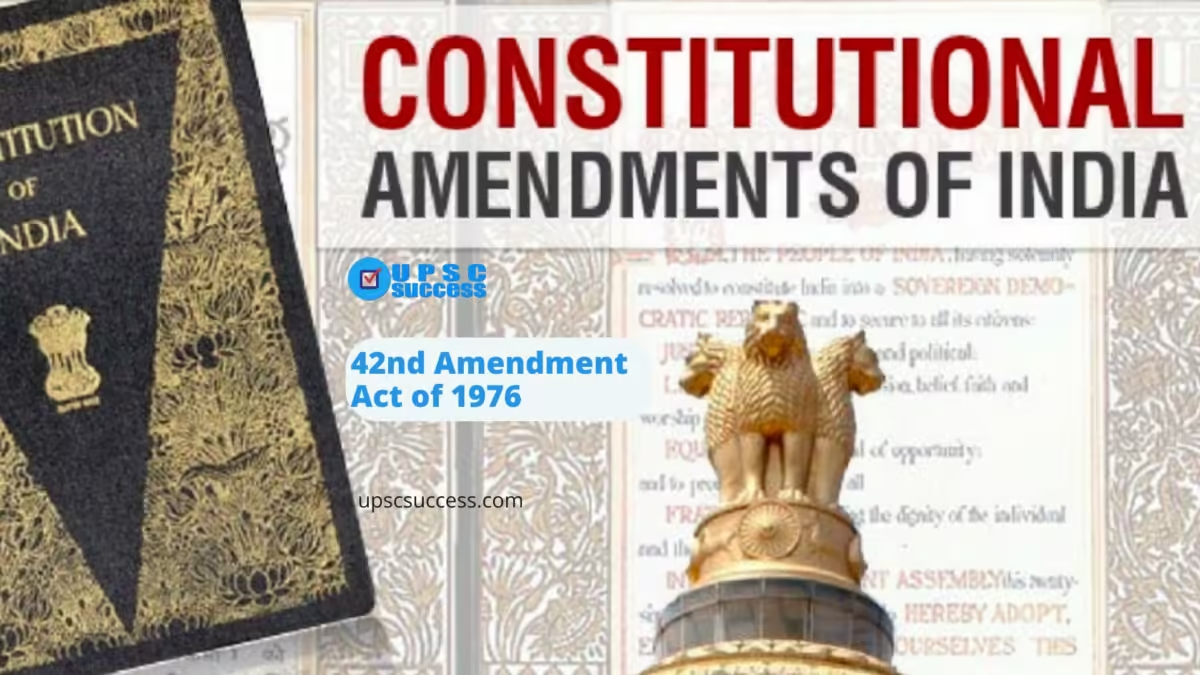Contents
The 42nd Amendment Act of 1976, also known as the “Mini-Constitution,” is one of the most significant amendments to the Indian Constitution. Enacted during the Emergency period (1975-1977) under Prime Minister Indira Gandhi, this amendment brought about comprehensive changes that affected nearly every part of the Constitution.
Here’s an in-depth look at the 42nd Amendment Act, its provisions, implications, and controversies.
42nd Amendment Act
The 42nd Amendment Act of 1976 remains a pivotal chapter in India’s constitutional history. It highlights the tensions between different branches of government and the ongoing debate about the balance of power in a democratic state.
Background and Context
The period of Emergency in India, declared by Prime Minister Indira Gandhi in 1975, was marked by significant political turmoil and stringent government control. The 42nd Amendment was introduced in this backdrop with the aim to fortify the central government’s power and limit the judiciary’s role in reviewing constitutional amendments.
The 42nd Amendment Act also made significant changes to the Preamble of the Constitution, adding the words “socialist” and “secular” to describe the nature of the Indian state. Additionally, the words “unity of the nation” were changed to “unity and integrity of the nation”.
42nd Amendment Act of 1976 added four new Directive Principles to the original list. Those DPSPs are:
- Article 39 – To secure opportunities for healthy development of children.
- Article 39A – To promote equal justice and to provide free legal aid to the poor.
- Article 43A – To take steps to secure the participation of workers in the management of industries
- Article 48A – To protect and improve the environment and to safeguard forests and wild life.
Some of the key Fundamental Duties introduced by the 42nd Amendment Act include:
- To abide by the Constitution and respect its ideals and institutions
- To cherish and follow the noble ideals of the freedom struggle
- To uphold and protect the sovereignty, unity, and integrity of India
- To defend the country and render national service when called upon to do so
- To promote harmony and the spirit of common brotherhood amongst all the people of India
- To value and preserve the rich heritage of our composite culture
- To protect and improve the natural environment, including forests, lakes, rivers, and wildlife
- To develop the scientific temper, humanism, and the spirit of inquiry and reform
- To safeguard public property and to abjure violence
- To strive towards excellence in all spheres of individual and collective activity
Key Provisions of the 42nd Amendment
- Preamble Changes: The amendment modified the Preamble to the Constitution, adding the words “Socialist,” “Secular,” and “Integrity” to describe India. These changes reflected the government’s intent to promote social and economic reforms and maintain national unity.
- Fundamental Duties: A new Part IV-A was added to the Constitution, introducing ten Fundamental Duties for Indian citizens. These duties aimed to promote a sense of responsibility and patriotism among the people.
- Directive Principles of State Policy: The amendment expanded the scope of the Directive Principles of State Policy (Part IV) by emphasizing socialist principles and setting goals for social and economic democracy. It mandated the state to secure the operation of the legal system to promote justice on a basis of equal opportunity.
- Judiciary and the Legislature: The amendment significantly curtailed the powers of the judiciary. It placed restrictions on judicial review, particularly concerning constitutional amendments, and transferred certain powers from the judiciary to the legislature. This move aimed to reduce the judiciary’s interference in legislative matters.
- Emergency Provisions: The 42nd Amendment Act reinforced the power of the central government during an Emergency. It extended the duration of President’s rule in a state from six months to one year and imposed stricter conditions for declaring a national emergency.
- Federal Structure: The amendment strengthened the central government’s control over states, diluting the federal structure by transferring numerous subjects from the State List to the Concurrent List.
Implications and Controversies
The 42nd Amendment Act faced significant criticism for several reasons:
- Centralization of Power: Critics argued that the amendment tilted the balance of power heavily in favor of the central government, undermining the federal structure of India.
- Judicial Independence: By restricting the judiciary’s power of review, the amendment was seen as an attack on judicial independence and an attempt to make the judiciary subservient to the legislature.
- Political Motivation: The timing and nature of the amendments were viewed as politically motivated, aimed at consolidating power and curbing dissent during the Emergency.
- Public Opposition: The amendment was perceived as an attempt to limit democratic freedoms and civil liberties, leading to widespread public disapproval.
Reversal and Legacy
Following the end of the Emergency and the subsequent electoral defeat of Indira Gandhi’s government in 1977, the succeeding Janata Party government took steps to undo many of the changes brought by the 42nd Amendment. The 43rd and 44th Amendments (1977-1978) restored the balance of power, reinstating the judiciary’s role and the federal structure of the Constitution.

